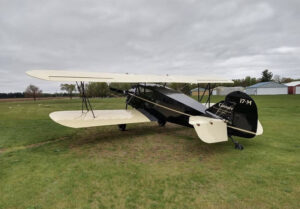Project Description

MPH
SEATS
Paramount Cabinaire
Role: Personal use Aircraft
National Origin: United States
Manufacturer: Paramount Aircraft
First Flight: 1929
Primary User: Civilian Owners
Number Built: Serial numbers through 9
The Paramount “Cabinaire” was an interesting example in a small family-type air-plane; trim and very compact, it didn’t have that big expensive look and seems to be a craft one would thoroughly enjoy owning and flying around the home port. Rather unusual too is the fact that the “Cabinaire” was an enclosed biplane and introduced at a time when the big switch was being made to monoplanes for a craft of this type. It doesn’t take much imagination to see the underlying purpose for this particular selection of configuration and realize that it was perhaps guided by a desire for an abundance of wing area around a fuselage that was hardly much bigger than the average 3 place biplane of the open cockpit type.
Consequently, the result of this selection is a petite 4 place airplane that is about 500 lbs. lighter than the average monoplane of this capacity with a performance on 165 h.p. that would otherwise not have been possible. Quite proud of the “Cabinaire” and rightfully so, Walter Carr demonstrated its ability on every opportunity; as a contestant in the hard-fought National Air Tour for 1930, he flew the “Cabinaire” model 165, NC17M, to 15th place amongst a very determined field.
Walter J. Carr, the designer of the “Cabinaire” biplane series, was a pioneer pilot that was well known in Michigan flying circles with exhibition flights that date back to at least 1915. Typical of many old-timers who saw plenty of room for improvement in the old crates they were then flying, Carr took a fling at building airplanes and designed the “Maiden Saginaw” in 1924.
Walter Carr undertook to test-fly the first Warner “Scarab” engine in 1927 which had been mounted in his own “Travel Air” biplane. With 156 hours of flying time recorded on this first Warner engine (Serial # 1), tests were pronounced satisfactory, the engine received its government approval and Carr fell heir to this first engine which he also later used in his first “Cabinaire” type. Stories vary to some extent as stories will, but from close examination of the prototype airplane in this series it is easy to believe that Walter Carr’s own “Travel Air” was the back-bone for his first “Cabinaire”, right down to the “elephant ear” ailerons and all. We could say that the “Travel Air” was added to here and there and modified into a “Cabinaire”. With flight tests performed and many lessons learned, the next “Cabinaire” though still very similar was redesigned in a personality all its own and in a craft that harbored many innovations. Organized late in 1928, Paramount Aircraft had their “Cabinaire” series in development for nearly a year before receiving government approval for manufacture.
The Paramount Cabinaire model 165 was a cabin biplane of rather petite proportion that seated 4 in fair comfort but in chummy proximity. Powered with the 5 cyl. Wright J6 engine of 165 h.p. performance compared favorably to the very best and economy per seat-mile was one of its cardinal features. Planned especially for the private owner or the low-budget business man, the “Cabinaire” cabin biplane was designed as an ideal family-type airplane or an economical air-taxi that could operate cheaply and easily in and out of smaller airports adjacent to the smaller towns, towns that one would find in out of way places and not be limited to the well developed airfields in the bigger cities. The first batch of “Cabinaires” were powered with the 110 h.p. Warner engine and it is surprising the performance that was available from this 4-seated craft; well arranged aerodynamically its behavior was positive and enjoyable. The type certificate number for the 165 h.p. Wright J6 (R-540) engine was issued 11-2-29 to Paramount Aircraft, Saginaw, Michigan.
NC17M, serial number 7, joined the museum collection in 2023.
General characteristics
- Crew: one pilot
- Capacity: three passengers
- Length: 24 ft 7 in
- Wingspan: 33 ft
- Height: 9 ft
- Empty weight: 1,620 lbs
- Max. takeoff weight: 2,630 lbs
- Powerplant: 1 × Wright J6 5-cylinder air-cooled radial engine, 165 hp
Performance
- Max Speed: 120 mph
- Cruise speed: 102 mph
- Range: 500 mi
- Service ceiling: 12,000 ft
- Rate of climb: 780 ft/min